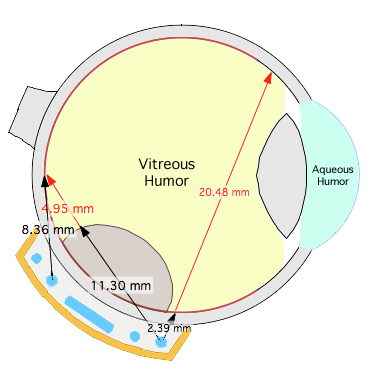The higher effective atomic number (Z) of silicone oil compared to that of water, or water equivalent fluids, results in increased attenuation (compared to water) of low energy radiation which traverses the oil. This occurs because attenuation for the low energies emitted by radionuclides such as I-125 and Pd-103 is predominantly the result of photoelectric interactions.
In photoelectric interactions the photon is absorbed and an electron is released. This electron loses its energy very rapidly, so the photon's energy is all deposited in matter very close to the site of the photoelectric interaction. There is no scatter. In general, the probability of photoelectric interactions (attenuation coefficient value) is proportional to Z3. The conditions that increase the probability of photoelectric interactions are low photon energies and high-atomic-number materials.
The objective of replacing the vitreous humor with silicone oil during eye plaque brachytherapy is to reduce the radiation dose to ocular regions outside of the tumor volume by surrounding the tumor with a fluid that has a higher effective atomic number than normal vitreous humor. The oil, however, can only attenuate radiation that traverses it. Therefore, destinations that are in the path of primary radiation which only passes through regions such as sclera, tumor, lens or anterior chamber will receive essentially the same dose regardless of what fluid occupies the vitreous chamber.
The ratio of radiation attenuation in silicone oil to attenuation in normal vitreous fluid will be proportional to the distance traversed in fluid in the vitreous chamber. The path length through fluid that crosses the vitreous chamber between a radiation source and a point of dosimetric interest will vary with the location of the dosimetry point, the tumor location, size and shape, and the position of the radiation source in the plaque.
The diagram on the right illustrates a standard COMS style plaque with a Silastic™ silicone seed carrier. Primary radiation emitted from the sources closest to a point of interest such as the fovea, if not removed by collimation, will deliver the dominant contribution to the dose at that point.
For this particular plaque and tumor location, primary radiation from one of these nearby seeds travels 8.36 mm, first through the seed carrier and then through sclera to reach the fovea. This radiation never encounters the vitreous chamber. Radiation from the furthest seed, which delivers the least dose at the fovea owing to the approximately inverse-square relationship of radiation intensity as a function of distance from the source, first travels 11.3 mm through seed carrier, sclera and tumor before reaching vitreous fluid. Only the final 4.95 mm of its total 16.25 mm journey passes through vitreous fluid where it would encounter silicone oil.

Radiation emitted from this same peripheral seed, which is directed towards the ora on the far side of the eye, first traverses 2.39 mm of seed carrier and sclera, followed by 20.48 mm through fluid as it crosses the vitreous chamber. The original intensity of this radiation, by the time it reaches the far side of the eye, will be primarily reduced by the following factors; inverse-square geometry (.0018), attenuation and scatter in water (.737), and a pair of additonal attenuation correction factors to account for greater attenuation in both the silicone seed carrier (.82) and silicone oil (.51) in the vitreous in comparison with otherwise water equivalent material. By far, the most significant factor affecting the dose received on the far side of the eye is inverse-square.